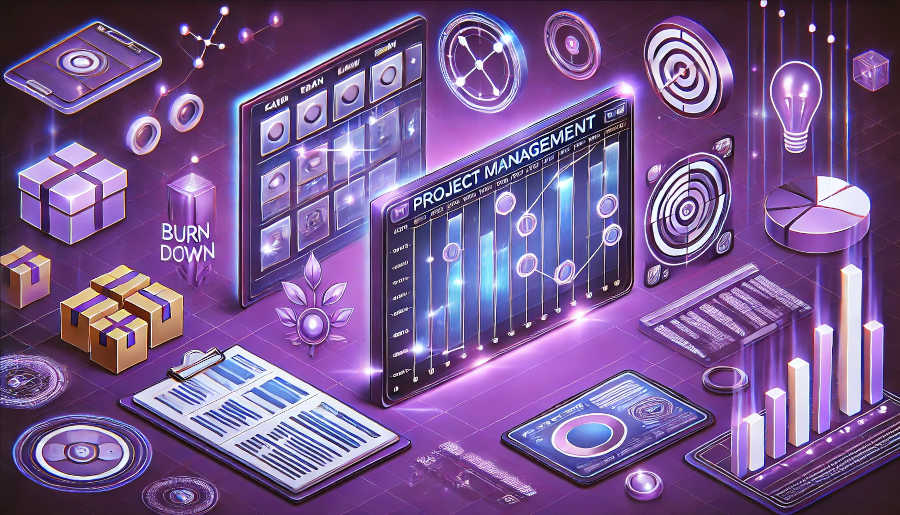Burn-down charts and project progress tracking are essential tools in project management. A burn-down chart is a visual representation that shows the remaining work over time in a project. It provides a clear picture of how the project is progressing towards its completion. Project progress tracking, on the other hand, involves monitoring various aspects of the project such as tasks, milestones, and resources to ensure that it is on track.
These two concepts are closely intertwined. The burn-down chart serves as a key component in project progress tracking. By regularly updating the burn-down chart, project managers can quickly assess whether the project is ahead, behind, or on schedule. It allows for early identification of potential issues and enables timely corrective actions to be taken. This helps in keeping the project on course and achieving the desired goals.
Moreover, both burn-down charts and project progress tracking contribute to better communication within the project team. The visual nature of the burn-down chart makes it easy for team members at all levels to understand the project's status. This transparency fosters a sense of accountability and collaboration, as everyone can see how their work fits into the overall project timeline and what needs to be done to keep it moving forward.
Understanding Burn-down Charts
A burn-down chart typically has two axes. The vertical axis represents the amount of work remaining, which can be measured in various units such as story points, hours, or tasks. The horizontal axis represents time, usually divided into intervals like days, weeks, or sprints in an agile project. As the project progresses, the amount of remaining work is plotted on the chart, creating a downward-sloping line.
The ideal burn-down chart shows a steady decline in the remaining work over time, indicating that the project is progressing as planned. However, in reality, the line may fluctuate. If the line is steeper than expected, it could mean that the team is completing work faster than anticipated, which might be a positive sign but could also indicate that the initial estimates were inaccurate. Conversely, a flatter line or an upward trend may suggest that the project is falling behind schedule, perhaps due to unforeseen obstacles or inefficiencies.
Burn-down charts are not only useful for tracking the overall progress of a project but also for analyzing the performance of individual team members or sub-teams. By looking at how different parts of the work are being completed over time, managers can identify areas where additional support or resources may be needed. This detailed analysis helps in optimizing the project workflow and ensuring that all aspects of the project are moving forward effectively.
The Role of Burn-down Charts in Project Progress Tracking
Burn-down charts play a crucial role in project progress tracking. They provide a real-time snapshot of the project's status, allowing project managers to make informed decisions. For example, if the burn-down chart shows that the project is behind schedule, the manager can investigate the reasons. It could be due to a lack of resources, dependencies not being met, or scope creep. Once the root cause is identified, appropriate actions can be taken, such as reallocating resources, resolving dependencies, or adjusting the scope.
In addition, burn-down charts help in setting realistic expectations. By showing the historical progress and the projected completion date, stakeholders can have a clear understanding of when the project will be finished. This is especially important for external stakeholders who may be relying on the project's deliverables. It reduces the chances of misunderstandings and ensures that everyone is on the same page regarding the project timeline.
Furthermore, burn-down charts can be used to measure the effectiveness of different project management strategies. If a new approach is implemented, the impact on the project progress can be observed through the burn-down chart. If the line shows a more favorable trend after the implementation, it indicates that the strategy is working. On the other hand, if there is no improvement or the situation worsens, it may be necessary to reevaluate the strategy.

Challenges in Using Burn-down Charts for Project Progress Tracking
While burn-down charts are valuable tools, there are several challenges associated with using them for project progress tracking. One of the main challenges is accurate estimation. Determining the initial amount of work, especially in complex projects, can be difficult. If the estimates are too high or too low, the burn-down chart will not provide an accurate representation of the project's progress. This can lead to incorrect decisions and mismanagement of the project.
Another challenge is dealing with changes during the project. Scope changes, new requirements, or unforeseen events can disrupt the original plan and make it difficult to update the burn-down chart accurately. Project managers need to have a process in place to handle these changes and adjust the chart accordingly. Failure to do so can result in a misleading burn-down chart and a false sense of the project's status.
Moreover, the interpretation of burn-down charts can be subjective. Different people may look at the same chart and draw different conclusions. For example, some may focus on the overall trend, while others may pay more attention to short-term fluctuations. This can lead to confusion and miscommunication within the project team. To overcome this, it is important to establish clear guidelines and communication channels for interpreting the charts.
Strategies for Effective Use of Burn-down Charts in Project Progress Tracking
To use burn-down charts effectively in project progress tracking, several strategies can be employed. First, invest time in accurate estimation. Use historical data, expert judgment, and collaborative techniques to come up with realistic estimates of the work. This will ensure that the burn-down chart starts with a solid foundation and provides reliable information.
Second, establish a regular update schedule for the burn-down chart. Team members should be encouraged to report their progress regularly so that the chart can be updated in a timely manner. This will keep everyone informed about the project's status and allow for quick identification of any issues.
Third, combine the use of burn-down charts with other project management tools and techniques. For example, use Gantt charts to show the overall project schedule and dependencies, and use key performance indicators (KPIs) to measure the project's performance in different areas. This holistic approach will provide a more comprehensive view of the project and enhance the effectiveness of project progress tracking.
Conclusion
In conclusion, burn-down charts and project progress tracking are integral parts of successful project management. Burn-down charts offer a visual and intuitive way to monitor the remaining work in a project over time, while project progress tracking encompasses a broader range of activities to ensure the project stays on track. The relationship between the two is symbiotic, with burn-down charts serving as a key tool in the progress tracking process.
Despite the challenges associated with using burn-down charts, such as accurate estimation and dealing with changes, when used effectively, they can provide valuable insights into the project's status. By following the strategies outlined, project managers can enhance the accuracy and usefulness of burn-down charts in project progress tracking. This, in turn, leads to better decision-making, improved communication, and ultimately, higher chances of project success. As projects continue to grow in complexity, the importance of these tools and their relationship will only increase, making it essential for project managers to master their use.
ARTICLE TITLE :The relationship between burn-down charts and project progress tracking ,AUTHOR :ITpmlib

















